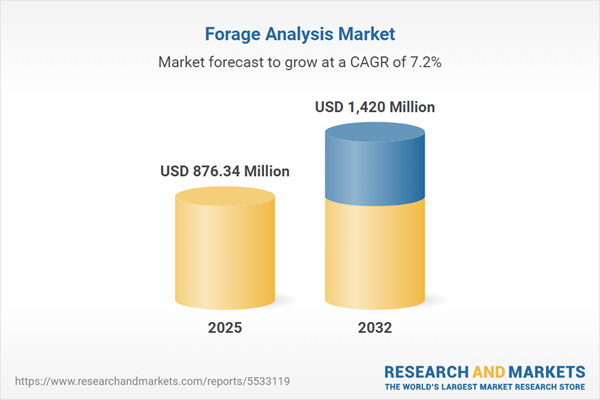Speak directly to the analyst to clarify any post sales queries you may have.
For senior agricultural executives responding to dynamic regulations and evolving feed quality requirements, forage analysis is a cornerstone for operational confidence, compliance, and risk mitigation. Optimizing supply chain integrity and adapting to new challenges requires timely, accurate insights from advanced forage analysis methods.
Market Snapshot: Forage Analysis Market Size and Growth
The global forage analysis market demonstrates a strong growth trajectory, with projected revenue increasing from USD 817.16 million in 2024 to USD 876.34 million by 2025, and reaching USD 1.42 billion by 2032. This sustained expansion reflects heightened food safety standards, rapid advances in livestock nutrition technologies, and rising demand for precision analytics. Decision-makers are investing in agile adaptation strategies and robust supply chain solutions to address increasing regulatory complexity and market shifts, making advanced forage analysis essential for maintaining operational advantage in the agri-food sector.
Scope & Segmentation of the Forage Analysis Market
The comprehensive scope of the forage analysis market enables leadership teams to prioritize innovation and strategic investment for optimized agricultural outcomes. Core segments include:
- Analysis Types: Covers digestibility evaluations, energy content measurement, determination of dry matter and moisture, microbial risk assessments, and detailed nutritional profiling. These analyses ensure feed quality and help meet compliance demands.
- Technology Platforms: Portable devices enable rapid, on-site forage testing, supporting responsive decision-making. Laboratory systems offer standardized, in-depth diagnostics suitable for multi-location and complex operational environments.
- Forage Forms: Encompasses testing of mixed, fresh, and preserved forages, allowing organizations to design nutrition programs that address regional and seasonal variability in supply.
- End-User Segments: Reflects the needs of agricultural producers, feed manufacturers, nutrition consultants, and regulatory agencies, each requiring tailored analysis capabilities for compliance, quality assurance, and efficiency.
- Regional Dynamics: Adoption rates and regulatory priorities differ among the Americas, Europe, Middle East and Africa, and Asia-Pacific. Recognizing these distinctions helps focus investment where compliance-focused analytics and advanced technologies provide maximum impact.
- Key Companies: Industry leaders such as Bruker Corporation, Cargill Incorporated, Eurofins Scientific, Intertek Group plc, and SGS SA play a pivotal role in advancing best practices and sector-wide standardization.
Key Takeaways for Senior Decision-Makers
- Integrating digital diagnostic platforms with laboratory-based solutions accelerates the delivery of actionable data for informed decision-making across feed supply networks.
- Flexible analysis tools empower organizations to adjust rapidly to changing environmental conditions and market demands, sustaining productivity and program alignment when forage quality or availability fluctuates.
- Modern data management practices and transparent analytics support efficient compliance monitoring and strengthen sustainability initiatives in agricultural operations.
- Quick detection of microbial threats and feed safety risks enhances operational resilience and supports maintaining a strong reputation as industry regulations evolve.
- Maintaining open communication with regulatory bodies ensures smoother technology adoption and positions organizations to respond swiftly to policy updates or industry changes.
Tariff Impact: Navigating US Tariffs in 2025
With new US tariffs set for 2025, both feed importers and domestic producers will experience increased sourcing costs, prompting reevaluation of procurement strategies. Organizations are responding by diversifying supplier bases, optimizing inventory management, and exploring alternative forage resources. Advanced analytics are critical, enabling businesses to maintain flexibility and operational continuity despite rapid changes in the trade environment.
Methodology & Data Sources
This report uses a multi-phase research approach, drawing on leading industry white papers, peer-reviewed publications, regulatory data sets, and direct interviews with senior agricultural executives. Real-world case studies are included to demonstrate effective strategies in complex operating environments.
Why This Report Matters
- Enables senior executives to anticipate and address vital shifts within the forage analysis market through informed, forward-looking strategies.
- Delivers practical recommendations that support supply chain resilience, addressing the nuances of regional compliance and technological responsiveness.
- Provides insights to enhance operational performance and preserve value throughout agricultural supply processes.
Conclusion
Strategic use of forage analysis empowers leaders to reinforce feed safety, drive sustainable sourcing, and foster dependable performance across the agricultural value chain.
Additional Product Information:
- Purchase of this report includes 1 year online access with quarterly updates.
- This report can be updated on request. Please contact our Customer Experience team using the Ask a Question widget on our website.
Table of Contents
3. Executive Summary
4. Market Overview
7. Cumulative Impact of Artificial Intelligence 2025
Companies Mentioned
The companies profiled in this Forage Analysis market report include:- Bruker Corporation
- Cargill, Incorporated
- Cumberland Valley Analytical Services, Inc.
- Dairyland Laboratories, Inc.
- Eurofins Scientific (Ireland) Limited
- Intertek Group PLC
- Massey Feeds
- R J Hill Laboratories Limited
- ServiTech, Inc.
- SGS SA
Table Information
| Report Attribute | Details |
|---|---|
| No. of Pages | 186 |
| Published | November 2025 |
| Forecast Period | 2025 - 2032 |
| Estimated Market Value ( USD | $ 876.34 Million |
| Forecasted Market Value ( USD | $ 1420 Million |
| Compound Annual Growth Rate | 7.1% |
| Regions Covered | Global |
| No. of Companies Mentioned | 11 |









